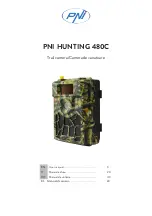
110
Technical Specifications
Genie Color Series-GigE Vision Camera
Sensor Handling Instructions
This section reviews proper procedures for handling, cleaning, or storing the Genie camera. Specifically the Genie
CCD sensor needs to be kept clean and away from static discharge to maintain design performance.
Electrostatic Discharge and the CCD Sensor
Cameras contain charge-coupled device (CCD) image sensors, which are metal oxide semiconductor (MOS) devices
and are susceptible to damage from electrostatic discharge (ESD).
Electrostatic charge introduced to the sensor window surface can induce charge buildup on the underside of the
window that cannot be readily dissipated by the dry nitrogen gas in the sensor package cavity. When charge buildup
occurs, surface-gated photodiodes (SGPDs) may exhibit higher image lag or a highly non-uniform response, with
some pixels displaying a much higher response when the sensor is exposed to uniform illumination. The charge
normally dissipates within 24 hours and the sensor returns to normal operation.
Important
: Charge buildup will affect the camera’s flat-field correction calibration. To avoid an erroneous
calibration, ensure that you perform flat-field correction only after a charge buildup has dissipated over 24 hours.
Protecting Against Dust, Oil and Scratches
The CCD window is part of the optical path and should be handled like other optical components, with extreme
care.
Dust can obscure pixels, producing dark patches on the sensor response. Dust is most visible when the illumination
is collimated. The dark patches shift position as the angle of illumination changes. Dust is normally not visible when
the sensor is positioned at the exit port of an integrating sphere, where the illumination is diffuse.
Dust can normally be removed by blowing the window surface using a compressed air blower, unless the dust
particles are being held by an electrostatic charge, in which case either an ionized air blower or wet cleaning is
necessary.
Oil is usually introduced during handling. Touching the surface of the window barehanded will leave oily residues.
Using rubber finger cots and rubber gloves can prevent oil contamination. However, the friction between the rubber
and the window may produce electrostatic charge that may damage the sensor.
Scratches can be caused by improper handling, cleaning or storage of the camera. When handling or storing the
Genie camera without a lens, always install the C-mount protective cap. Scratches diffract incident illumination.
When exposed to uniform illumination, a sensor with a scratched window will normally have brighter pixels
adjacent to darker pixels. The location of these pixels changes with the angle of illumination.
Содержание Genie Color C640
Страница 90: ...88 Operational Reference Genie Color Series GigE Vision Camera...
Страница 94: ...92 Network Overview Tools Genie Color Series GigE Vision Camera...
Страница 101: ...Genie Color Series GigE Vision Camera Technical Specifications 99 Genie 3D View with Right angle C mount and CS mount...
Страница 118: ...116 Technical Specifications Genie Color Series GigE Vision Camera EC FCC Declaration of Conformity...
Страница 130: ...128 Glossary of Terms Genie Color Series GigE Vision Camera...
















































